
Image composition showing Saeed Ali Khamis Al-Kaabi (left) and Tariq Saleh (right). Photo: Jambiya Journal.

Orinoco Tribune – News and opinion pieces about Venezuela and beyond
From Venezuela and made by Venezuelan Chavistas

Image composition showing Saeed Ali Khamis Al-Kaabi (left) and Tariq Saleh (right). Photo: Jambiya Journal.
By Aldanmarki – Oct 15, 2025
News from Yemen rarely reaches the headlines these days. For the past two years, global attention has been consumed by Israel’s horrific and psychopathic bloodletting in Gaza, with the world equally surprised by Yemen offering its unconditional and stubborn military support for the oppressed Palestinian people.
Before October 2023, however, the crisis in Yemen was widely labeled the world’s worst humanitarian disaster. Millions were living on the knife’s edge of starvation, trapped by a suffocating blockade so brutal and fundamentally illegal that it seemed almost impossible to fathom.
Since 2015, Saudi Arabia has led a regional coalition, with backing from the United States and Britain, in a campaign to undo Yemen’s September 21st Revolution of 2014. Ten years on, their efforts have yielded nothing but abject and embarrassing failure.
The 2022 UN-sponsored ceasefire froze open hostilities, allowing warring parties to entrench themselves. The Sana’a-based government and the endless array of proxy forces it has long battled now govern their territories with uneasy permanence.
It should surprise no one familiar with the conflict that foreign powers have long funded, armed, and trained local proxies to advance their political and economic agendas. Saudi Arabia has served as the chief patron of the so-called “Internationally Recognized Government”—a body that holds little real authority on the ground—while the UAE has nurtured what can best be described as a smorgasbord of often competing militias, most notably the separatist Southern Transitional Council and, since 2018, the “National Resistance” led by former dictator Ali Abdullah Saleh’s nephew Tariq Saleh, along Yemen’s embattled West Coast.
In recent weeks, a series of leaked Emirati documents from 2021, first reported by veteran Yemeni journalist Anis Mansour, have surfaced online. Although their authenticity has yet to be independently verified, I find them credible enough to warrant public attention. They shed light on the machinery driving the occupation of South Yemen and expose the UAE’s deliberations with its proxies as they carve up the country for ends that serve not Yemenis, but the geostrategic ambitions of neo-mercantile powers determined to keep the Peninsula’s only republic fractured, divided, and perpetually unstable.
(Note: Each covered document will contain a download link. While all the pages are included in each PDF file, I cannot guarantee correct page sequence.)
Bargaining for a tribal head
Among the leaked files is a document titled “Minutes of the Military Operations Area Meeting – Marib, Al-Bayda, Ibb, Taiz,” stamped with the official letterhead of the UAE Ministry of Defense. Its opening page contains a letter signed by Saeed Ali Khamis Al-Kaabi, publicly known as the Director of Humanitarian Operations for the Emirates Red Crescent in Yemen, yet identified here as a Brigadier General and commander of the “West Coast Forces.” A designation, it seems, that was never intended for public eyes.
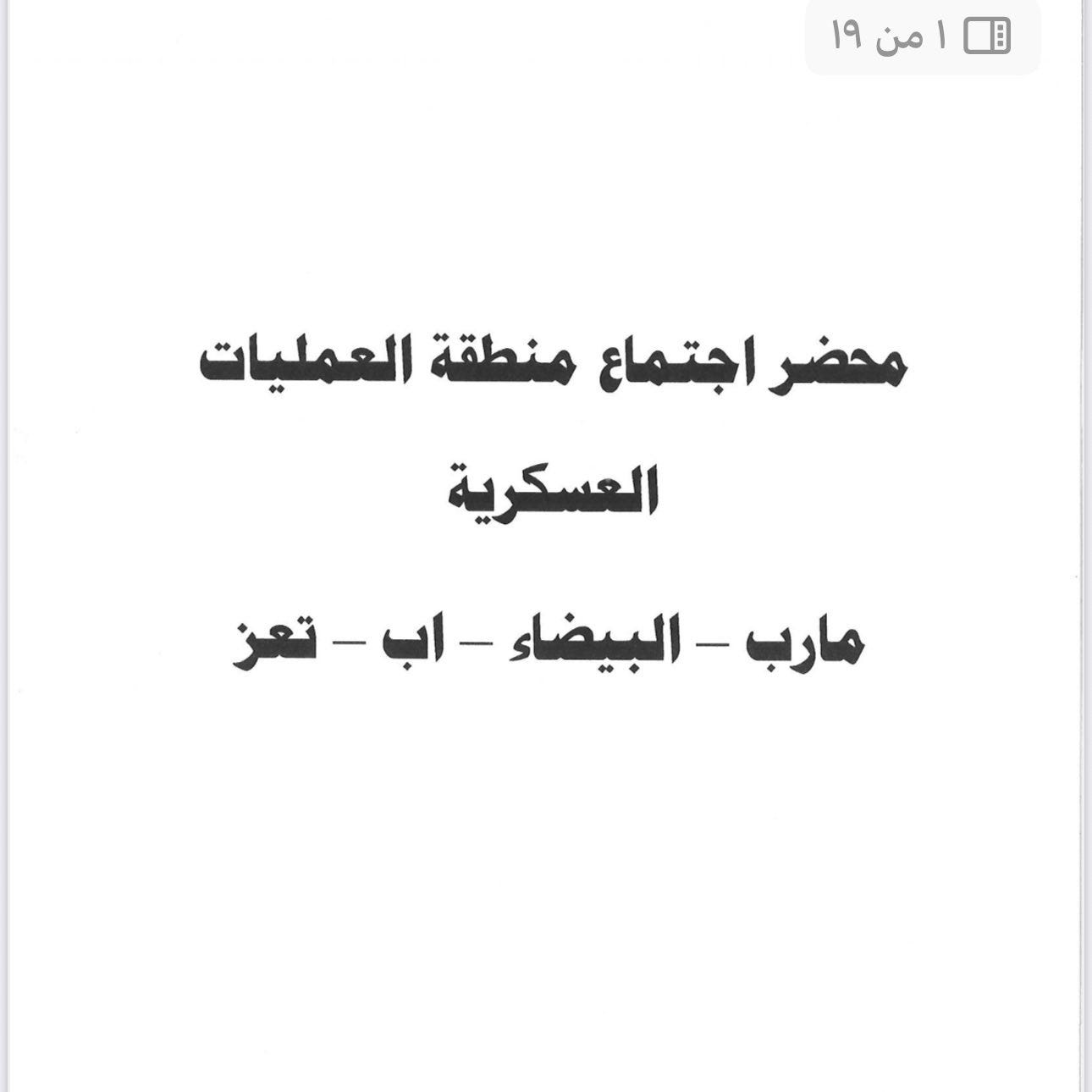
(PDF: Minutes Of The Military Operations Area Meeting Marib, Al Bayda, Ibb, Taiz)
The letter is addressed to Major General Saleh bin Muhammad Al-Amiri, officially serving as Commander of Joint Operations in the UAE Armed Forces. Al-Amiri is a central military figure within the Saudi-led Coalition and has played a key role in directing both Emirati troops and allied proxy forces across southern Yemen.
The accompanying letter to Maj. Gen. Al-Amiri indicates that the meeting minutes were prepared for his personal review. It quickly becomes clear that the following pages outline plans for a potential military campaign aimed at dislodging Yemen’s Shabwa province from its surroundings, presumably in order to cement direct Emirati control over the territory.
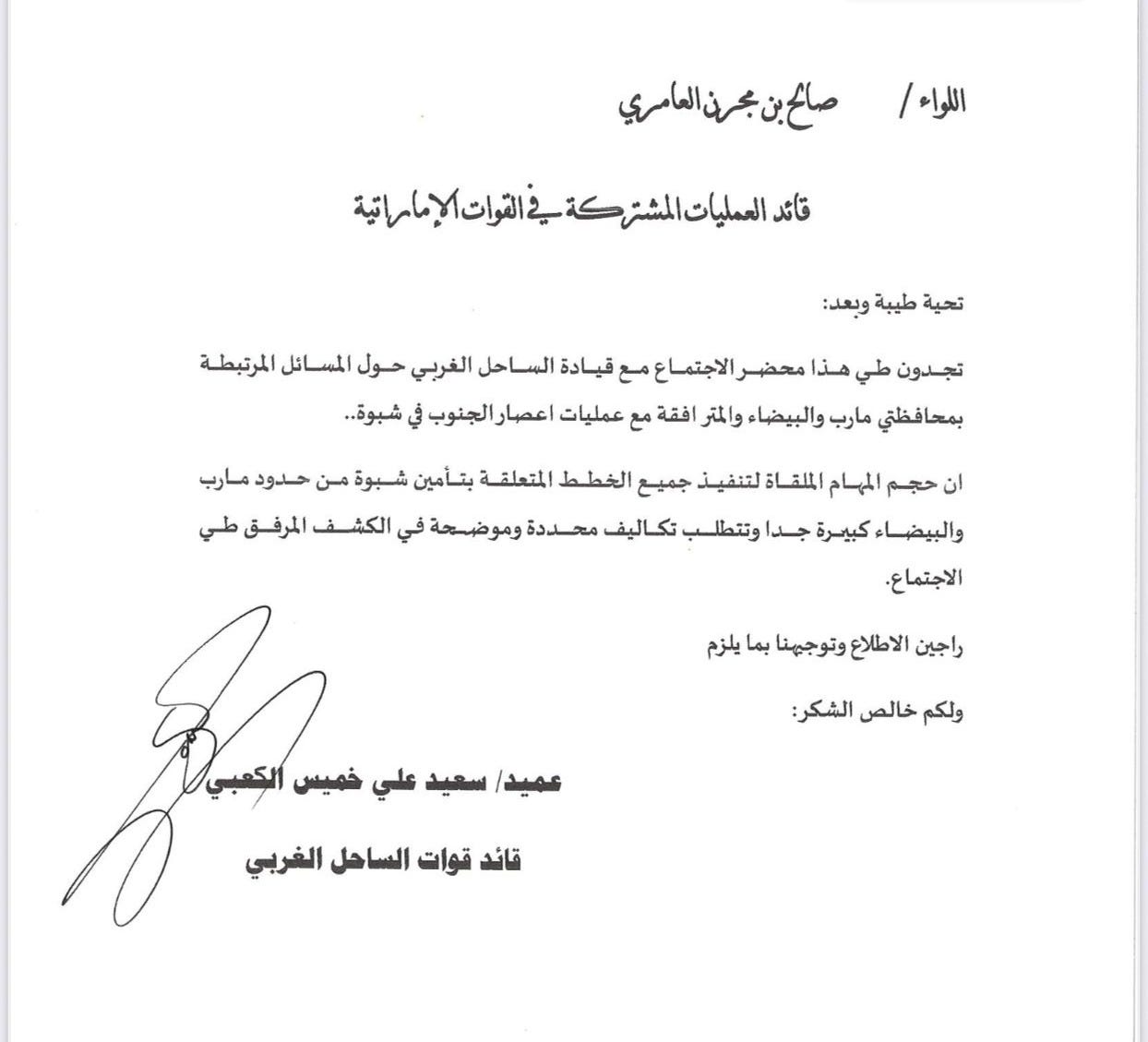
The document then provides a concise summary of the meeting’s agreed points, detailing the allocation of resources for what are described as “polarization operations” in Marib, Al-Bayda, and Taiz. In this context, “polarization” refers to efforts to recruit or sway influential tribal and political figures through bribery and other inducements.
The document then lists the date of the meeting, May 8th, 2021, and senior attendees, primarily three figures linked to the “National Resistance.” Present were Tariq Saleh—the nephew of former president Ali Abdullah Saleh and current commander of the “National Resistance”—his brother Ammar Saleh, and the aforementioned Brigadier General Saeed Al-Kaabi.
What follows is a stark transcript of the meeting, laying bare the unvarnished strategy for Yemen’s future. Brigadier General Al-Kaabi begins not with battlefield tactics, but with a plan to systematically buy the loyalty of an entire region. He instructs his Yemeni allies to “polarize every important and influential person in Marib and Al-Bayda.” Ammar Saleh confirms the scale of the operation, presenting a preliminary list of 35 key personalities in Marib alone. When Al-Kaabi asks about the price, Ammar’s response is chillingly direct: “Every head can be bent for a million dirhams.”
Tariq Saleh elaborates on this transactional approach to alliance-building, offering a grim proverb that seems to define their strategy: “You cannot buy the loyalty of a tribe, but you can rent this loyalty for a specific amount and for a known period of time.” The plan, as detailed, is warfare by checkbook, aiming to fracture northern Yemeni society from within by turning its leaders into paid assets.
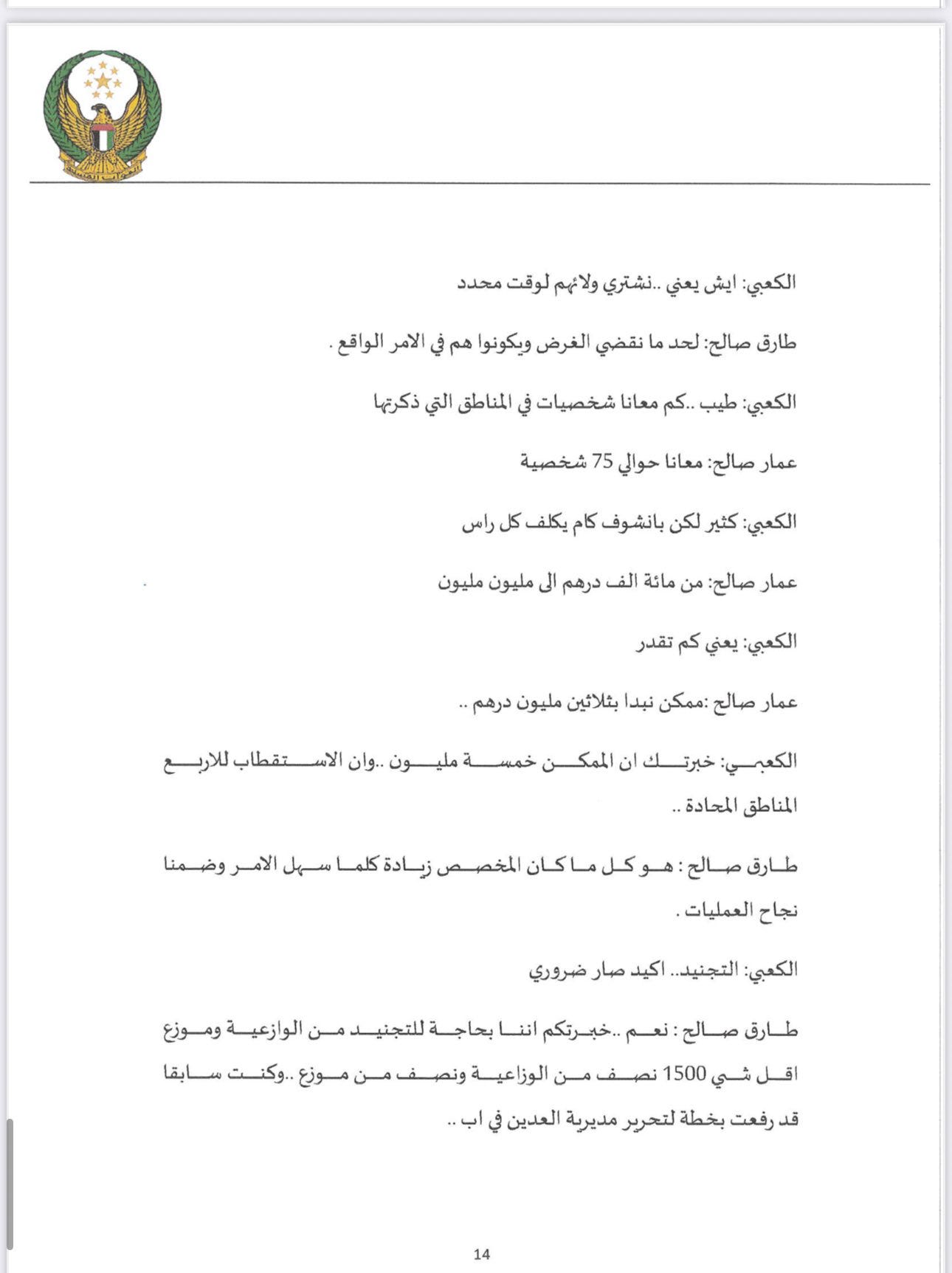
The minutes reveal that the ultimate target of this operation is not solely the Ansar Allah movement. In one of the most explosive revelations, Brigadier General Al-Kaabi tasks his allies with preparing a plan for “specific operations to completely eliminate the Legitimacy”—a direct reference to Yemen’s so-called “internationally recognized government”, the very entity the Saudi-led Coalition was officially there to prop up. This objective is coupled with a secondary plan to “deal with Al-Qaeda in Al-Bayda,” but the priority is unmistakable.
The geopolitical maneuvering behind this strategy is laid bare when the Saleh brothers are instructed to remove Saudi-aligned figures from their lists of polarization targets. When questioned, Al-Kaabi explains that the Emirati and Saudi leadership have reached a deal: “Saudi Arabia will concede all southern governorates in exchange for us putting our full military weight into the war.” This admission points to a backroom agreement to partition Yemen into spheres of influence, with the UAE securing control over the strategic south. To enforce this, Tariq Saleh is ordered to conduct a 100km withdrawal of his forces, a command he calls “very embarrassing” but is nonetheless expected to obey.
The tactics discussed extend beyond bribery into overt economic warfare. Tariq Saleh proposes a plan for Ibb governorate that includes “an exceptional bombing that destroys the economic environment,” which he suggests should be “accompanied by the withdrawal of currency.” This strategy aims to induce chaos and cripple the region’s economy, deliberately targeting civilian infrastructure to achieve military goals.
The meeting also highlights the deeply cynical nature of the conflict’s alliances. When the challenge of confronting Al-Qaeda in Al-Bayda is raised, Ammar Saleh offers a startlingly pragmatic solution: “The areas… where Al-Qaeda is concentrated, we leave them to the Ansar Allah (Houthi) group. They are capable of dealing with them.” The admission that the coalition would outsource its counter-terrorism fight to its primary enemy reveals the fluid and self-serving priorities governing the war.
Throughout the transcript, a palpable tension over money and corruption lingers. Al-Kaabi openly accuses his Yemeni partners of graft, questioning where the funds from past operations have gone: “The results on the ground are less than 10% of what is expected… where does the other 90% go, ya Ammar?” Yet, in the same breath, he cynically institutionalizes it, instructing them to factor in their own cut. “Don’t forget to put in Ammar’s share,” he says, adding, “there is no harm if he buys a few villas and a palace in Germany. We consider it a reward for you.”
A secret alliance revealed
A second, more explosive document from the leaked cache provides an unprecedented look into the covert architecture of the UAE’s war in Yemen, revealing a deep and fraught alliance with Israel and their key Yemeni proxy, Tariq Saleh. Titled “Report on the Resistance’s Relationship with Israel,” the 25-page file is an internal Emirati investigation into Saleh’s unsanctioned dealings with Israeli intelligence. It paints a vivid picture of a partnership built on strategic necessity but plagued by profound mistrust, culminating in a dramatic confrontation where the Emiratis move to bring their unruly ally to heel.
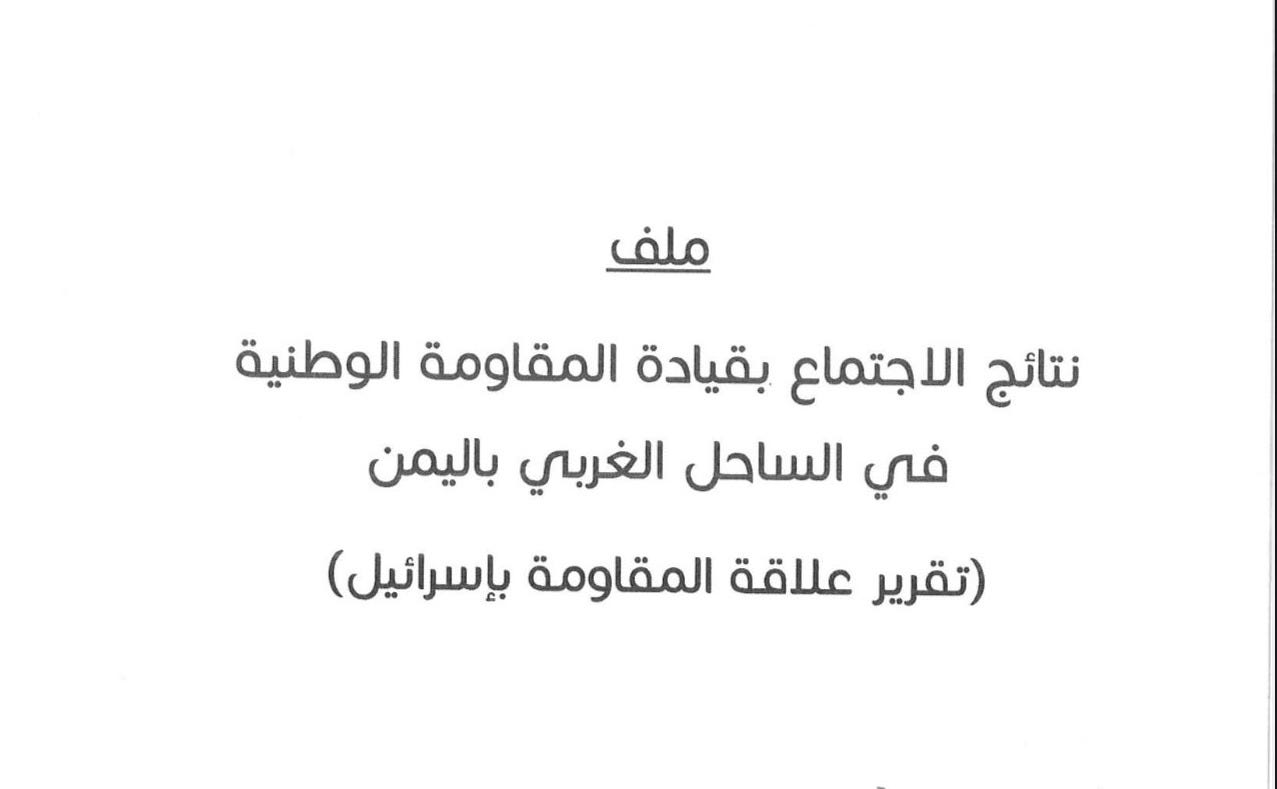
Notably, the entire document is presented on official Emirates Red Crescent stationery. This peculiar detail strongly suggests a deliberate blurring of lines between humanitarian aid and covert operations, indicating that Saeed Ali Khamis Al-Kaabi leverages his humanitarian position to mask his parallel role in military and intelligence activities.
Before detailing Saleh’s transgressions, the report first establishes the official, extensive military cooperation between the UAE and Israel on Yemen’s Western Coast, which is hardly a distant, arms-length relationship. The document meticulously tables joint operations throughout 2018 and 2020, including:
This foundation of sanctioned cooperation makes the subsequent accusations of clandestine side-dealings all the more significant.
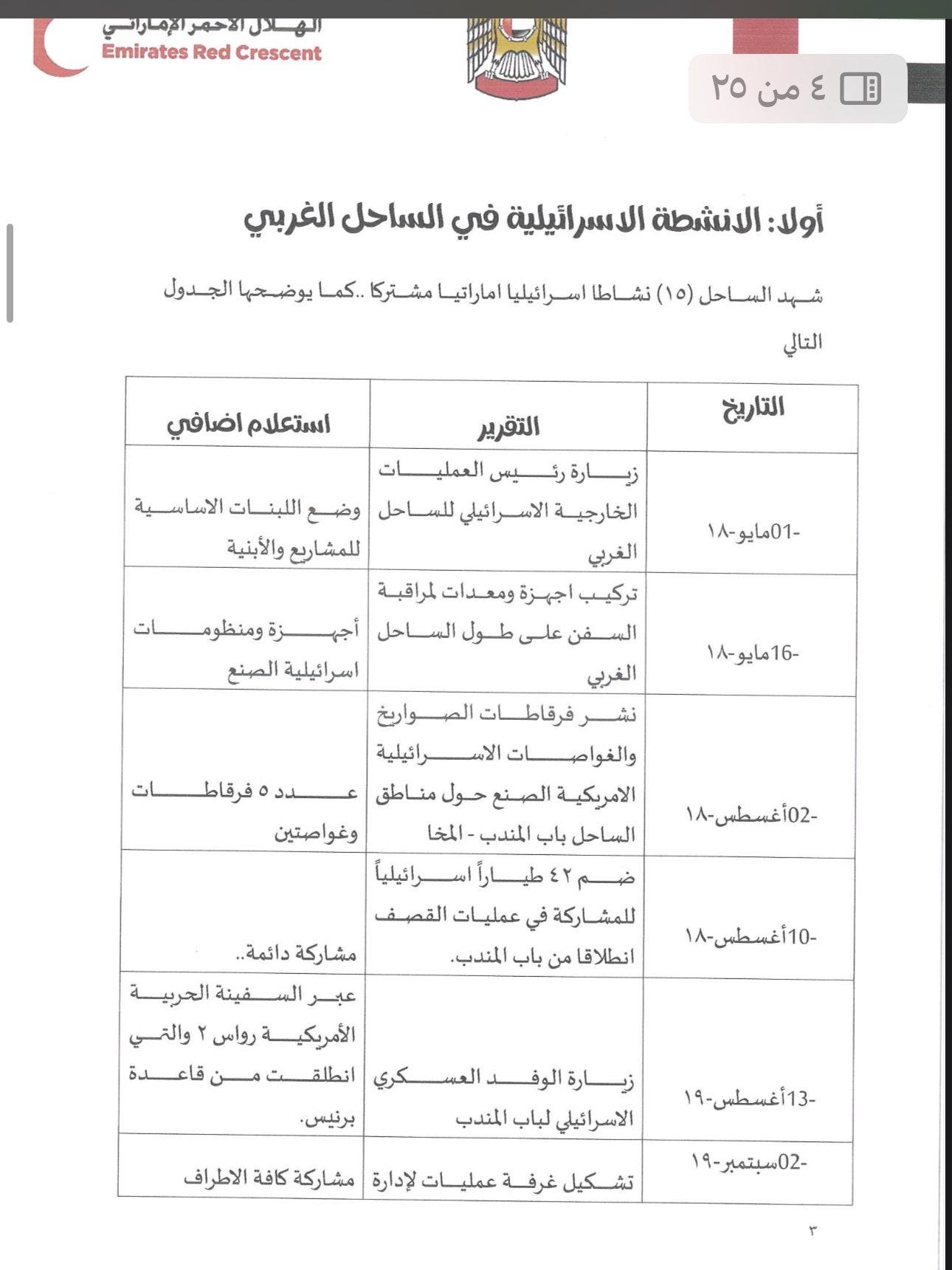
The heart of the document is the transcript of a tense meeting on October 10, 2021, at the command headquarters in Mokha. Emirati commanders, led by Brigadier General Saeed Al Mazrouei and Brigadier General Saeed Al Kaabi, effectively put Tariq Saleh on trial for his perceived betrayals.
The Emiratis open with a clear accusation of disloyalty. “Let’s be clear, we operate based on what we know about you,” Al Mazrouei began, adding with a thinly veiled threat, “and we are confident that you have been communicating with the Americans and Israelis outside of our approved channels. It seems you are looking for alternative patrons in case we decide to leave you.”
Saleh’s denials are repeatedly brushed aside as the commanders present a list of specific infractions:
Having laid out their case, the Emirati commanders deliver their verdict. Saleh’s autonomy is to be severely curtailed. “The operations room will be restructured, and from now on, you will be nothing more than an external observer,” Al Mazrouei commanded. “We will establish a new, official channel for your communications with the Israelis, one that will be completely transparent to us.”
The meeting takes a historic turn when the Emiratis reveal the deep roots of this relationship. Al Kaabi informed Saleh that his uncle, the late President Ali Abdullah Saleh, was the original architect of the alliance. “The relationship between your uncle, the martyr, and Israel was more than excellent,” Al Kaabi revealed. “His cooperation with them began back in 2007,” he continued, adding the stunning detail that “your uncle even visited Tel Aviv for a secret two-day meeting with Netanyahu.”
Rather than being chastened, Tariq Saleh embraced this history. “I was simply a soldier following orders then,” he responded. “It was my uncle, the martyr, who began this relationship, and I intend to continue on the path he started.”
The Emirati commander’s stunning revelation that Ali Abdullah Saleh maintained a “more than excellent” relationship with Israel, culminating in a secret visit to Tel Aviv to meet with Netanyahu, might seem incredible. Yet, this claim is not without precedent and appears to confirm long-standing allegations about the former dictator’s covert dealings. In October 2020, the Yemeni Armed Forces of the Sana’a-based government published a highly detailed report documenting the increasingly tight relationship between Saleh’s regime and Israel. Yemeni military officials listed several incidents proving this relationship, such as:
The leaked minutes, therefore, do more than expose the actions of Tariq Saleh; they lend significant weight to the charge that his family’s political survival had long been tied to a hidden, pragmatic, and deeply cynical back-channel relationship with Tel Aviv.
The meeting concludes with a discussion of future plans. The UAE pressures Saleh to publicly announce his support for normalization with Israel, a move he resists, citing the “inherently hostile” political climate in northern Yemen.
A solution is then proposed for encouraging Israeli investment on the Western Coast without provoking a public backlash. The commanders agree that Israeli investors should use foreign passports to hide their origins. Saleh proposed an open invitation for them to come with “European, Ukrainian, or similar passports and invest,” calling it “an invitation for them to launder their identities.”
Gold rush in the east
The third and final leaked document covered in this article, titled “Special Document: Results of Mineral Exploration Activities in Al-Mahra Governorate, Yemen,” reveals a detailed and audacious plan by the United Arab Emirates to secure and exploit vast mineral resources, particularly gold, in eastern Yemen. The 18-page report, prepared by the UAE’s Special Unit (T) in Yemen and addressed to the Joint Operations Command, functions as a confidential geological survey, a political risk assessment, and a strategic blueprint for overcoming local resistance to seize control of what it estimates to be a very lucrative, unexplored gold deposit.
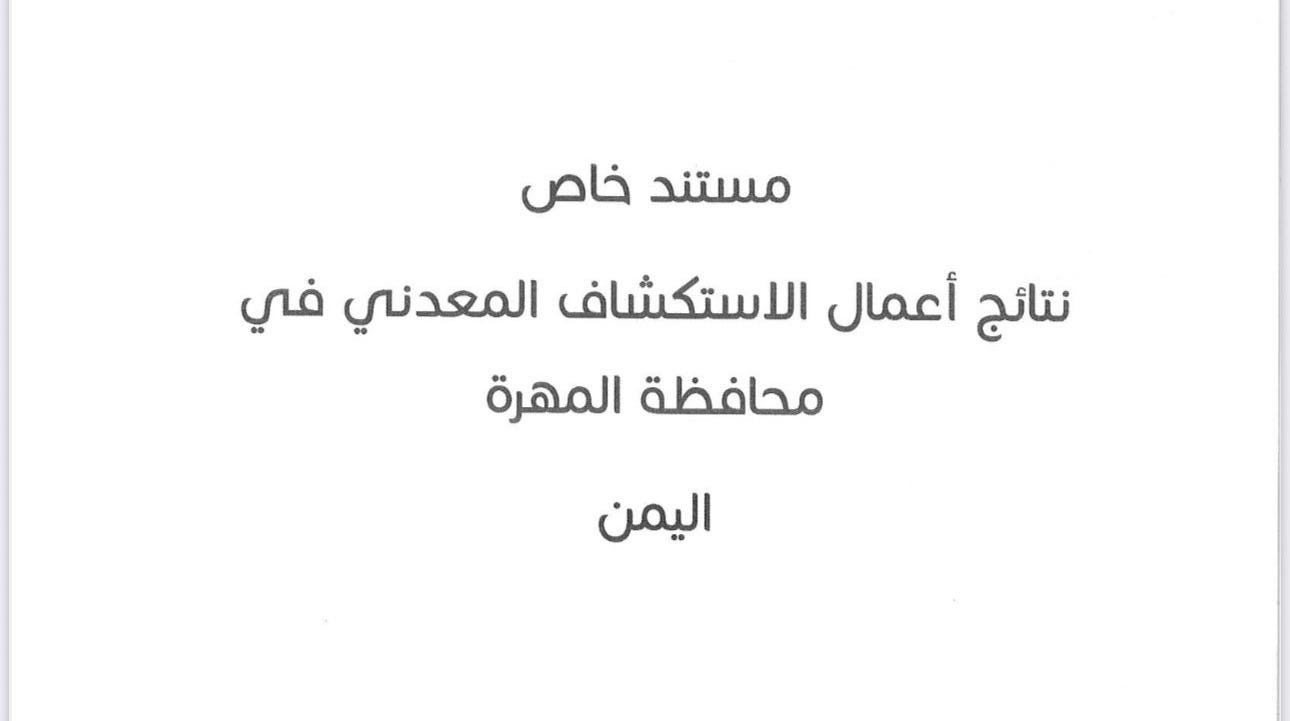
(PDF: Special Document Results Of Mineral Exploration Activities In Al Mahra Governorate, Yemen)
The report frames its mission under a political guise. It begins by citing an agreement with its key Yemeni ally, the Southern Transitional Council (STC), which allegedly tasks the UAE with helping the STC achieve southern “independence” by extracting the region’s mineral wealth.
To provide a legal basis for the operation, the report invokes a 2005 license granted by former President Ali Abdullah Saleh to Thani Dubai National Mining for gold prospecting in Hadhramaut. The document argues that a clause in this old license allows for its expansion into the adjacent Al-Mahra governorate, a legal justification it has bolstered with a new deal concluded with the “head of the legitimate government.”
To execute the plan, the report details the creation of a new company operating under the cover of “Thani Dubai.” This firm secured an agreement, ostensibly to prospect for emeralds, but the report makes clear the real targets are far more valuable. In exchange for granting a 50-year concession for prospecting and exportation rights, the Yemeni Prime Minister and the STC’s Minister of Transport were to be “rewarded with millions of dollars.”
The core of the document is the stunning results of the exploration survey, conducted by a handpicked international team of experts from Egypt, Palestine, Syria, Brazil, Ukraine, and the UAE. After conducting geological mapping, rock sampling, and analysis, the team presented its staggering conclusions. The report confidently asserts that Al-Mahra holds (kilograms per cubic meter (kg/m³):
(Note: A previous rendition of this article concluded the preliminary results to be in the millions, which is geologically impossible. This came from a misreading of the table in the document, and has since been corrected)
The document also notes significant deposits of nickel, lead, copper, and silver, concluding that Al-Mahra “holds a great deal of this wealth,” making Yemen potentially one of the richest mineral zones in the world.
Despite the immense potential wealth, the report dedicates significant space to detailing the formidable obstacles standing in the way of extraction. It outlines six primary challenges:
The final section of the report lays out a detailed and ruthless strategy to overcome this widespread resistance. The proposals amount to a comprehensive plan to militarize the region and co-opt local leaders:
A colonial blueprint
What emerges from these scattered pages—a meeting about bribes, a tense confrontation over Israel, a corporate-style plan for a gold rush—is not a series of isolated events, but a single, chillingly coherent blueprint for the subjugation of a nation. As I sifted through the minutes, the mechanics of the UAE’s agenda came into sharp focus, revealing a strategy that is as cynical as it is meticulous.
The first document shows us the ‘how’: a war fought with checkbooks, where a commander casually discusses the price of loyalty “per head” and plans are laid to “completely eliminate the Legitimacy”—the very government the coalition claimed to be saving. This is a world where corruption isn’t just tolerated but encouraged, with proxies offered “villas in Germany” as a reward for their compliance.
The second document reveals the ‘who’ and ‘why’: a deep-seated, covert military alliance with Israel, designed to project power across the Red Sea region. This partnership is so vital that even their own proxy, Tariq Saleh, must be brutally disciplined for stepping out of line, his secret dealings exposed and his autonomy curtailed. The minutes confirm a long history of these back-channel arrangements, tracing them back to a secret meeting between Tariq’s uncle and Benjamin Netanyahu, framing the current conflict as merely the latest chapter in a decades-long game. Crucial to mention, however, is that Israel’s attempt at regional power projection in the Red Sea region has the past two years been proven entirely futile, and have not been able to stop the Ansar Allah from conducting its operations in support of & solidarity with the Palestinian people – among other things.
Finally, the third document lays bare the ultimate prize: the cold, hard calculus of economic extraction. Here, we see the blueprint for a neo-colonial venture, with detailed plans to seize Al-Mahra’s allegedly rich gold deposit. The local population, with their legitimate resistance to foreign occupation, are not seen as people to be won over, but as obstacles to be managed through a combination of a new, 5,000-man proxy militia, targeted bribes, and a full-spectrum propaganda campaign. The solution to dealing with Israeli investors in a hostile environment? A cynical directive to have them “launder their identities” with foreign passports.
This blueprint for resource extraction is not unique to Yemen. It finds an uncanny parallel in Sudan, where the UAE has been a key foreign backer of the brutal Rapid Support Forces (RSF) in their devastating war against the Sudanese army. For years, reports have detailed how Emirati support—in the form of weapons, financing, and diplomatic cover—has fueled the RSF’s campaign. The motive, as it has become increasingly clear, mirrors the agenda laid out in the Al-Mahra report: to secure privileged access to Sudan’s vast gold deposits. By propping up a powerful militia with a history of controlling the country’s mines, the UAE is once again using a proxy force to advance an extractive agenda, ensuring that the immense wealth beneath the soil flows not to the Sudanese people, but into the vaults of Abu Dhabi. The tactics may be adapted, but the goal remains the same: leveraging conflict to secure a permanent stake in another nation’s natural resources.
The authenticity of these documents can and will undoubtedly be debated, but the pattern they reveal is too consistent to ignore. This is the machinery of an oft-forgotten occupation, one that seeks to control a nation not by winning hearts and minds, but by purchasing loyalties, managing assets, and carving up resources. They reveal a vision for Yemen not as a sovereign state to be rebuilt, but as a fractured dominion to be managed, its people a problem to be solved, and its wealth a prize to be claimed.
Support Groundbreaking Anti-Imperialist Journalism: Stand with Orinoco Tribune!
For 7 years, we’ve delivered unwavering truth from the Global South frontline – no corporate filters, no hidden agenda.
Last year’s impact:
• More than 200K active users demanding bold perspectives
• 216 original pieces published in 2025 alone
Fuel our truth-telling: Every contribution strengthens independent media that actually challenges imperialism.
Be the difference: DONATE now to keep radical journalism alive!